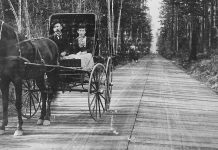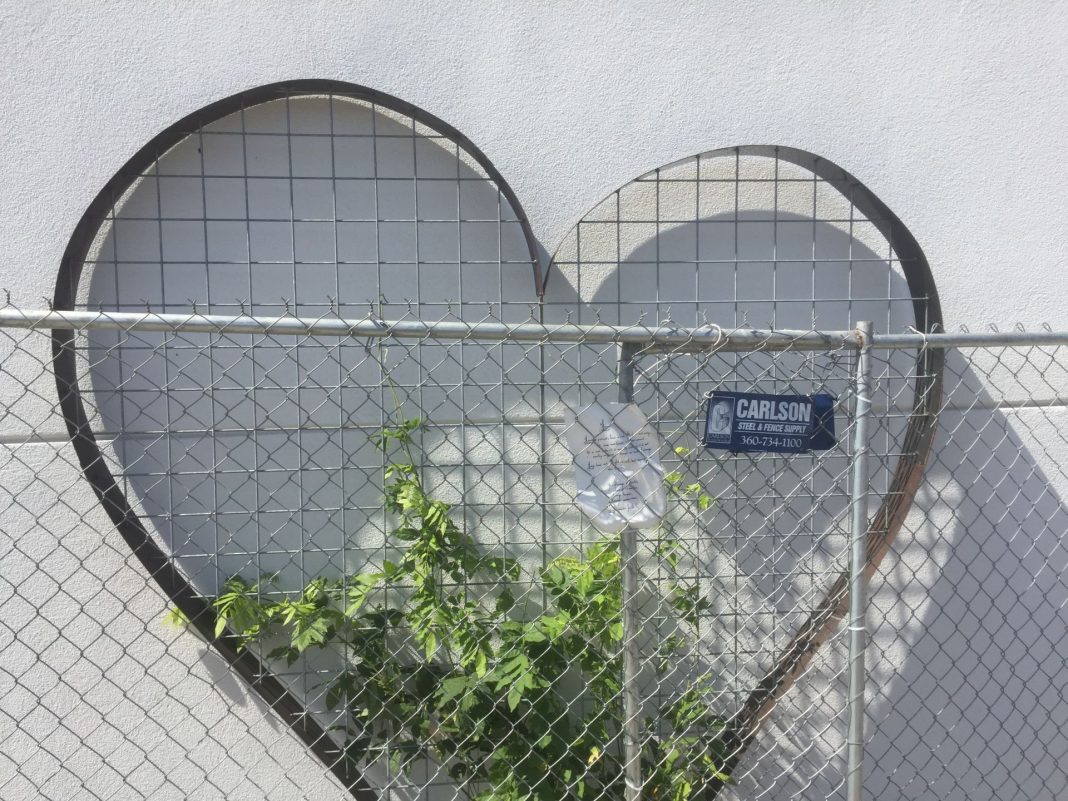I met Alex McLean about four years ago as he and I were on the City of Bellingham Transportation Commission together. At the time, McLean wanted the city to create a community garden and public park on top of the parkade (now referred to as the Commercial Street Parking Garage) since the top floor was severely underutilized as a parking area. His idea was creative, colorful and Bellingham-ish, but the city did not bite. Years later I’ve come to find out he’s active in other things including the Granary Rehabilitation in the Waterfront District.
McLean applied for the project manager job to potentially be the first Bellinghamster to work for Harcourt, the Irish development company working with the Port of Bellingham to redevelop the former Georgia Pacific Plant site, now called the Waterfront District. Although they ultimately opted to use one of their own managers, McLean later got invited to do demolition and prep work for the Granary Building. At the time, this was welcome news. He was going through a divorce so any chance to run around with a chainsaw and swing a sledgehammer was a welcome respite to his personal life. “My brain was fried, total mush,” McLean said, “so I looked at it as a really unhealthy version of therapy.”

Being safety conscious, he rigged himself to a harness and worked for the majority of 2016 cutting through old Douglas Fir timber and ripping apart the roof. His feet punched through the rotten roof several times while working on the replacement, McLean said, but an occasional rock climbing hobby seems to have prepared him for that inevitability. One of his other demolition tasks, especially satisfying given his mindset, was to help savagely remove Bellingham’s ivy heart, the iconic symbol that had graced the side of the building for the past decade. The vines, “some thick as a baby’s arm,” as McLean described them, had broken through a window and had caused significant damage to the wall. While McLean doesn’t know who installed or maintained the heart, he said the Art Collective across the street had something to do with it. “They are a secretive lot,” McLean said, “very into their anonymity.”
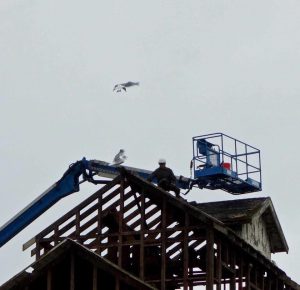
During the building’s remodel, people throughout the community became concerned about the fate of the Granary’s well-known Heart. It had been known for years as a sort of green mascot, after all, and was a wildly popular photography backdrop. Was it going to be demolished as well? Yes, indeed it was.
Working together with Harcourt and the Port of Bellingham, McLean ended up welding a steel trellis and attachment system that has been installed on the rehabilitated building. A decision was made to use a flowering jasmine vine instead of the English Ivy as it is a less invasive species and would not damage the building. McLean promises that the Heart will get bigger, that more trellis will be added to it as the vine grows. “We know it is smaller,” McLean said, “but that was kind of by design. It would have looked ridiculous if it was 20 feet tall with a two-foot sprout at the bottom.” After a week of vandalism where the plant was repeatedly torn out, the jasmine is now fenced in and hopefully will get a chance to fill the trellis over the coming years.

McLean no longer works for Harcourt full time, preferring to take on odd jobs, experiment with sculpture projects and, recently, go back to school to refresh his computer design skills. Although concerned about some of the setbacks and slow progress on the site, McLean is excited for what the community will gain once the pieces fall into place.
“That park, right there over the waterway, and the Granary right next to it will be awesome,” he said. “There are two-foot by three-foot timber beams in there, everywhere. Despite the ankle-deep pigeon poo and the fossilized rat skulls, this building is going to end up really, really cool – a huge asset to Bellingham.”
McLean, as he proved during his effort to put a park on top of Bellingham’s garage, is an avid supporter of seemingly wild ideas. One of the best ideas he’s seen for the larger Waterfront District project is to abandon the planned smattering of random, small parks and just build one long, fat ribbon of greenery through the whole development. “It just makes total sense to me from a landscape urbanism perspective,” McLean said.
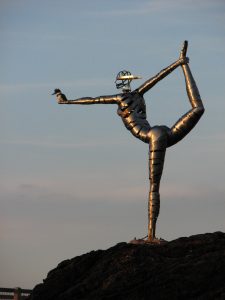
Aside from his briefer stint on the Transportation Commission, McLean just finished two full terms on Bellingham’s Greenways Advisory Committee. As a park and trail advocate, he hopes the city and the port will reconsider a ribbon-like central park to tie together downtown, the Waterfront District and even Fairhaven. Not only would this design provide a non-motorized transportation corridor, McLean notes, but from a developer’s perspective having frontage and access to greenery is always an asset. “There’s 200 acres of dead-level gravel down there right now,” McLean said, “so the time to think about connectivity from Cornwall Beach to Downtown is now, before we slather buildings all over the place.”
McLean said he has been in construction for 20 years, about five of which were in project management or supervising roles. “I’d see something weird headed to the dumpsters and would haul it over to my truck instead,” McLean said as he confessed to being, “a hoarder of random crap I can’t use.” It was only after attending his first Burning Man arts and music festival in 2007, that McLean saw the inspiration needed for his recycled piles.
The festival, a week-long conclave held in a remote Nevada desert, surprised him for being very construction-oriented. For McLean, the real impact of the event wasn’t the structures so much as the art. He became especially obsessed, he said, with the massive sculptures he saw at these festivals.

His yard, in Bellingham’s Happy Valley neighborhood, is now filling up with various projects he has taken to Burning Man over the years. One of these, a slightly larger-than-life version of a woman in a yoga pose, ended up being infamous once McLean dragged it out to a small island in the middle of the night and bolted it to the rock. “A lot of people called her ‘the Dancer,’” McLean said, “but I always called her ‘Grace.’ When I took her to Burning Man in 2011 (temporarily) I put her in the middle of a buddy’s massive sculpture and called the whole thing ‘Pressure under Grace,’ so it stuck.”
McLean said that he knew the sculpture would be jarring to the community – he didn’t have permission and told nobody of his impulsive plan – so he sent the Cascadia Weekly an anonymous letter in hopes of explaining himself. “Yeah, people freaked out,” McLean said, noting that it was a bit surreal to be sitting next to the former Parks Director, James King, at Greenways and Parks Board meetings McLean had to attend, as King described the city of Bellingham’s possible responses to his weird act of vandalism.
“Ultimately it was endorsed and allowed, kind of grudgingly,” McLean said. “But I never felt right about it.” After a year or two of being on the rock, getting rusty from the constant exposure to sea salt, McLean decided to end the experiment and took the sculpture down. Today Grace is in his back yard, under a cedar tree. Although he tried to maintain his anonymity over the years, enough people had identified him successfully that, when he applied for a design contest to enhance the so-called “Acid Ball,” a future element of the Whatcom Waterway Park, McLean decided to out himself as the culprit. “I’m fine with it,” he joked, “handcuffs and Tasers are nothing new to me.”
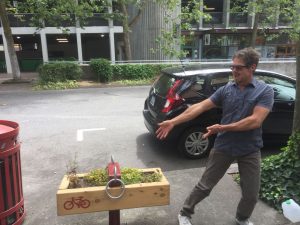
McLean recently joined the board of the Happy Valley Neighborhood Association and has been pushing the city to create a park within the neighborhood. McLean likes Bellingham because, “People here are invested in the community. They show up to meetings, they volunteer their time and stay engaged to make Bellingham a better place. They understand place-making. It’s intuitive to citizens here,” he describes.
As I finished up talking with McLean over sandwiches at the Brandywine Cafe, he said something odder than usual, “I gotta water my dumpster.”
I was confused. Is he hoping to compost some of his saved-up building materials at home? I thought to myself.
“Come on, I’ll show you.” He grabbed two gallons of water and walked to the alley east of the parking garage. There, just south of a line of real dumpsters, is a dumpster of rusty steel and wood – recycled hoarding bits gleaned from the Granary and other projects he’d worked on. Inside are plywood cutouts of flame shapes mixed with flowers and shrubs. McLean said he got a text from a city employee that suggested nobody cared enough about alleys to worry what he did, so he did this. “It lights up at night too,” McLean said, “because, really, what dumpster is complete without lights?”
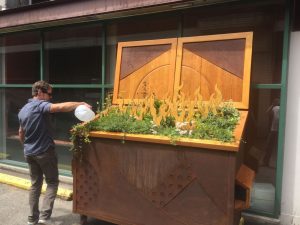
As we headed back through the alley, McLean noted the unique history and character of some of Bellingham’s alleys and his hope that the city, perhaps working with Kapow! coordinators or the Downtown Bellingham Partnership, might invest in small efforts like his. “It wouldn’t take much to make these places really cool,” McLean said. “They don’t have to be off-limits dead-zones.”
Once we were back on Commercial Street, McLean pointed out one of the bike racks with planters that he made and placed at various downtown spots. No, he wasn’t paid by the city to build them. Yet, they stand and many have used them for years.
I came away from my interview in awe. Who does that? Who spends time and money to place art and functional bike racks in a city on their own? We need people like Alex to better our community. We need his creativity. We need his ideas. Thanks Alex for making Bellingham a better place! Thanks for volunteering your time and energy to make our city more equitable. Thanks for making our alleys and bike racks more beautiful.
*
Got an idea for someone you’ve always wondered about? Maybe you already know them but think they deserve some lime light. I’m looking to get to know others that make our community a better place, a unique place, maybe even a stranger place. Drop me a line at submit@whatcomtalk.com.








